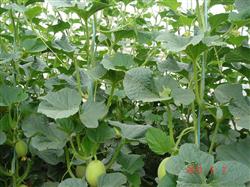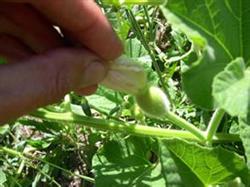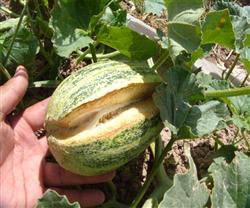The reasons and overcoming measures of muskmelon not bearing melon

The germination period is from seed germination to cotyledon expansion. The length of germination period is mainly related to temperature. Normally, this period is 5-10 days, which varies with different varieties and seasons. When the local temperature is 28 ℃, when the water is sufficient, the seedling can emerge in 3-4 days, and when the ground temperature is 20 ℃, the seedling emergence time is 7-10 days. The optimum germination temperature of muskmelon was 2832 ℃, and most varieties could not germinate below 15 ℃. The optimum soil water content for seed germination is about 10%. If it is less than 8%, the germination rate will be reduced; if it is higher than 18%, it will also affect the germination. In addition, seeds are light-resistant, that is, seeds like to germinate in the dark. The seedlings in the germination stage mainly grow on the nutrients stored in the two cotyledons of the seeds, and the growth is small in this stage, and photosynthesis can be carried out after the cotyledons are expanded. During this period of time, the seedbed should maintain appropriate temperature and humidity to prevent the seedlings from overgrowing. When the seedlings break their hearts and reveal their true leaves, the germination period ends. The seedling stage is the seedling stage from cotyledons spreading and true leaves breaking to three leaves with one heart, which normally takes 20-25 days. During this period, the root system began to grow vigorously, the length of the main root could reach about 35 cm, and a large number of lateral roots occurred and distributed in the surface layer of soil 20 cm to 30 cm. This stage is also the stage of flower bud differentiation, and at the end of the seedling stage, the stem tip differentiates into about 20 nodes. Under the condition of 30 ℃ in daytime, 18-20 ℃ at night and 12 hours of sunshine, the flower bud differentiated early and the fruiting flower node was lower. Under the condition of high temperature and long sunshine, the node position of fruiting flowers is higher, and the quality of flowers is poor. The quality of seedling management has a direct impact on the morning and evening of flowering and fruit setting and the level of yield. The seedling stage of muskmelon cultivated in winter and spring is not suitable for the growth of muskmelon, so conditions should be created to make the seedlings grow in a suitable environment. The key point of management is to raise the ground temperature and loosen the soil, so as to make the seedlings grow strong and solid. The extension period from the fourth true leaf to the opening of the first female flower takes 25 to 30 days, during which the aboveground and underground parts of the plant grow rapidly at the same time. The plant changed from erect growth to creeping growth, the vegetative organs and reproductive organs on the main vine continued to differentiate, and the plant entered the vigorous growth stage. In the cultivation and management of vine extension, the combination of promotion and control should be achieved, which should not only ensure the rapid growth of stems and leaves, make the plant have larger nutrients, but also prevent the stem and leaves from growing too much. The growth of stems and leaves is good, which can lay a good foundation for flowering and fruiting. In this period, we can properly topdressing and watering, and through technical measures such as pruning, we can properly control the growth of stems and leaves in order to regulate the growth of plants. The fruiting stage is from female flower blooming to fruit ripening. The length of fruiting period is related to the characteristics of varieties. The fruiting period of early-maturing varieties is 30-40 days, and that of late-maturing varieties is 60-80 days. According to the characteristics of fruit growth and development, the fruiting stage can be divided into early fruiting stage (young fruit stage), middle fruiting stage (expanding melon stage) and late fruiting stage (mature stage). The main results were as follows: (1) in the early fruiting stage, it took 5-7 days from the flower blooming to the rapid expansion of young fruit, and the plant in this period gradually changed from stem and leaf growth to fruit growth. The ovary cells divide sharply before and after flowering. The focus of this period of management is to promote plant fruit setting. Pruning in time before fruit, artificial pollination and other measures can promote melon fruit setting and prevent flower and fruit drop. (2) after 5-7 days of flowering in the middle fruiting stage, the fruit began to expand rapidly, and from then on to the middle fruiting stage, the fruit grew fastest, while the growth of stems and leaves slowed down significantly. During this period, the nutrients produced by leaves through photosynthesis are continuously transported to the fruit, which makes the fruit expand rapidly, which is the most critical period for the formation of fruit yield. The focus of management is to strengthen fertilizer and water management, maintain exuberant photosynthesis of leaves, and ensure adequate water and nutrient supply of fruits. (3) in the late fruiting stage, the fruit stopped expanding and tended to mature. In this period, the growth of roots, stems and leaves gradually stagnated, and the fruit was basically shaped. During this period, except that the fruit continued to accumulate nutrients, the main characteristics were as follows: the sugar content of the fruit increased continuously, the chlorophyll gradually disappeared, the fruit showed the unique color, net pattern, aroma, flavor and quality of each variety, and the firmness began to decrease. In order to ensure the normal ripening of fruit, we should strengthen management, protect leaves and promote roots, and prevent premature senescence or susceptibility of stems and leaves. Due to the weakening of root absorption capacity of plants during this period, foliar fertilizer spraying should be carried out to supplement nutrition and control diseases in time. During fruit ripening, watering should be controlled, no watering or less watering, so as to improve the flavor and quality of the fruit. For most melon varieties, the above three stages exist obviously in the fruiting period, but for a few varieties, the above stages are not obvious, and the growth of muskmelon grows in an almost straight line, rather than the usual "s" curve. Results during the period, muskmelon had strict requirements on temperature, 2730 ℃ in daytime and 1518 ℃ at night, the temperature difference between day and night was more than 13 ℃, and sufficient light was required. During the harvest period, the fruit reaches physiological maturity, or when it begins to reach the level of harvest, it enters the harvest period. For thin-skinned melons and thick-skinned melons with layered melons for many times, the fruiting period and harvest time overlap. Fruit maturity is mainly judged by the color of the pericarp, pattern, pulp texture and so on. In this period, the sugar content of the pulp reached the highest value and exuded fragrance. Early harvest will affect the quality of muskmelon; too late harvest will affect economic income, so we must achieve timely harvest. The relationship between melon growth and melon fruiting 1. The relationship between vegetative growth and melon growth whether the stem and leaf growth of melon is exuberant or not directly affects the number of melon. The vigorous growth of stems and leaves can increase the number of female flowers, and when the female flowers increase to a certain extent, it can increase the melon setting rate. Leaf is the organ of plant photosynthesis, in a certain range, the leaf area increases, the yield and sugar content also increase accordingly. 2. Effect of pruning on growth and fruiting of melons pruning controls the growth of leaf vines to some extent. The results showed that the fresh weight of leaf vines of both single-vine and double-vine pruning plants was lower than that of unbridled ones, and that of double-vine pruning was lower than that of single-vine pruning. From the point of view of fruit growth, single-vine pruning is faster than laissez-faire growth and double-vine pruning, indicating that the number of leaf vines retained by single-vine pruning is more suitable for fruit growth than laissez-faire growth and double-vine pruning, and the coordination of vegetative growth and reproductive growth is more reasonable, so it can promote fruit growth. The fruit setting rate of pruning is higher than that of non-pruning, and the yield of single-vine pruning is higher than that of double-vine pruning. This shows that pruning controls the growth of leaf vines and promotes melon fruiting. Therefore, pruning is a technical measure that can not be ignored in melon cultivation, and the grower must be familiar with it and master it flexibly. The reasons why melons do not bear melons and the measures to overcome them although there are many female flowers in melons, sitting melons have an impact on the growth and fruiting of melons in the future. Sitting melon is in the exuberant period of leaf vine growth, the growing point of branches and young melons compete for nutrients with each other, resulting in a contradiction between vegetative growth and reproductive growth, resulting in falling flowers and fruits. Stiff buds, stiff fruits, resulting in a reduction in the number of fruits. Secondly, there is no pollination or no pollination conditions during flowering, or adverse environmental factors such as high temperature and drought may cause bud, flower and fruit ossification. The methods to improve the melon setting rate are as follows: (1) do a good job of pruning and coring, adjust the relationship between vegetative growth and reproductive growth, and improve the ventilation and light transmission conditions among plants, so as to increase the rate of pollination and melon setting; (2) on the basis of applying base fertilizer, topdressing should be done well in order to promote seedlings, stabilize seedlings and promote melon continuously and effectively; (3) artificial auxiliary pollination, especially in protected cultivation, can not be ignored. (4) timely and moderate watering, especially to ensure a moderate water supply during the melon setting period, can increase the melon setting rate, and too much water is not conducive to melon setting. (5) spraying growth regulators such as B9 for overgrown plants. Zhuangsu, Zenggualing, etc., control the growth of leaf vines and promote reproductive growth. To sum up, it can be seen that in order to solve the problem of melon growth and melon fruiting, it is necessary to scientifically apply measures such as fertilization, irrigation, pruning, vine management and coring according to the respective growth and development laws of thick-skinned melon and thin-skinned melon. Then through timely topdressing to meet the needs of fruit development, to prevent leaf vines from growing, so as to achieve the purpose of producing more melons and big melons.
- Prev

Fertilizer requirements of muskmelon
According to the fruiting habits of muskmelon, there is no pollen on the female flower tip, but there is pollen around the Corolla. It is necessary to manually pick the Corolla and pour out the pollen, and apply a little of the pollen to the female flower stigma with a brush. But it should be noted that artificial pollination must choose sunny days without dew and keep the brush clean, otherwise pollination will not succeed.
- Next

Cultivation techniques of muskmelon "three avoidance"
Scientific fertilization. According to the law of fertilizer and water demand during muskmelon growth, balanced supply of fertilizer and water, do not blindly water and fertilize. When fertilizing, we should not only apply sufficient base fertilizer to meet the needs of muskmelon growth in the early stage, but also apply fertilizer in time in the late growth stage of muskmelon to meet the fertilizer requirements of muskmelon growth in the later stage. Reasonable irrigation.
Related
- Moge, come on! The staff of the peasant association in the producing area of cantaloupe were frightened when the crowd gathered.
- Causes and Solutions of low Fruit setting rate of Apple
- Symptoms and control measures of passion fruit virus disease
- Fruit growing lesson: how do apple orchards keep high yields?
- Can you build orchards in the mountains? What are the pros and cons?
- How to manage the coloring period of Crisson grape?
- This paper introduces the processing technology of two kinds of fig products.
- How much is a month for retired teachers in rural areas by 2020?
- How can strawberry planting increase sugar content? We should pay attention to management in many aspects.
- What are the cultivation techniques on how to improve the yield of golden fruit?

